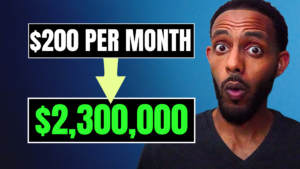If you’re like me when I started saving for retirement then you probably have a lot of questions and concerns about where, how and what to put your money in. And that is a natural place to be in when you begin to take your financial future and retirement seriously. Believe me nobody has all the answers and if you meet anyone who says they do I have one word of advice for you: RUN! Even the great Warren Buffet cautioned us when he said “Beware of geeks bearing formulas.” No one can predict the future of the stock market and there isn’t a magic trick to turn you into a multi-millionaire over night. However, we can look at the past and study it so that we can make safe choices and yield the best results possible.
Key to saving for retirement
The biggest key to investing is time. And the sooner you start no matter where the market is, the better off you will be in the future. A seed that is planted a year ahead of another seed will grow and depending on the type of seed, will bear fruit sooner than the second seed. Not necessarily faster, just sooner. And that is why time is one of the most critical components of your financial future. So after this blog I hope you will feel motivated to go and at the very least, open a retirement savings account and start your path to financial freedom. In this blog I am going to cover the questions and concerns I had when I started investing in my 401(k) and the lessons I’ve learned along the way.
Why save and invest?
Why do this right? Simply put, it’s the smartest thing you can do with money to help you secure your financial future and the future of your family or those you care about. Saving and investing in a tax-advantage retirement account opens doors you otherwise would not have been able to open on your own income. Also, YOU WILL WORK TOO HARD to not have anything show for it at the end of your career.
Where do I invest?
In one way or another everyone who works has access to a retirement savings plan such as a Traditional IRA, Roth IRA, 401(k), SEP IRA, 403(b), 457(b) or SIMPLE IRA.
How much do I invest?
Ideally, you’re going to want to be able to invest the maximum allowed into a retirement savings account the government will allow per year. I want you to save and invest at least 30-50% of your income. This is going to get you to retirement faster. Many financial personalities suggest you save and invest at least 10-15% of your monthly income. What this means is that a 25-year old who invests 10% of his $20k annual salary in an S&P 500 Index fund for 40 years can possibly retire with $1.6 million. This is based on a past study of the average of all the 40-year returns of the S&P 500 since 1928 by investment professional Paul Merriman.
The most remarkable aspect of someone retiring in 40 years investing $173/mo and potentially earning $1.6 million is that your total contribution equates to about $83k or just 5% of your earnings! Over the span of 40 years you retired a millionaire and only came out-of-pocket $83k to get there! At the same time you give yourself options to have an additional savings account on the side, pay off your house, fund college for your kids, travel, donate to charities and so many other things you want to do. All the while you stayed diligent and saved just $173/mo. I really hope you all see that virtually anyone can do this.
What do I invest in?
Here is the part I believe scares so many people from investing and I understand the fear, because I was once there myself. But I want you to think about what exactly you’re investing. When you invest in a stock you’re depending on the success of the one company you bought a stock from. Now doing this for one company is something you never want to invest do, because if that company ultimately fails then you fail with it. Leave investing in single stocks to Warren Buffet. So how do us regular folk invest in the market? Mutual funds. A mutual fund basically allows someone to invest in a range of companies and industries at one time. So you stay diversified and manage any risk of loss to a minimum. I’ll probably write a blog just about mutual funds very soon, but just remember to keep expenses low and that you’re better off in the long run investing in what’s called an index fund before investing in an actively managed fund. Like I said I will definitely write something about mutual funds, but those are my two criteria when choosing a mutual fund. If you need general help feel free to contact reach out.
To get an understanding of what index funds to get started with, I want you to look at the Total Stock Market fund at three different companies and understand how these are all related and how they are different: Charles Schwab Total Stock Market Index Fund SWTSX, Fidelity’s Total Stock Market Fund FSKAX or zero fee option FZROX, and Vanguard’s Total Stock Market Index Fund VTSAX. All 3 of these mutual funds invest in the same way, the total stock market of the U.S. They have different fees, different minimum investments and some other differences. But I want you to get with an investment professional and sit down and learn this stuff! I recommend getting started with the Charles Schwab’s SWTSX and I’ll explain in the next point why. But, like I mentioned I will definitely write another blog just about mutual funds and the awesome opportunities regular investors like you and me have with these options.
How do I open a retirement savings account if I don’t have access to a 401(k) or 403(b)?
This part is unknown to a lot of people and many of us don’t realize we have access to mutual funds, CDs, or a high yield savings in a tax-advantaged account. If you don’t have a retirement plan at work then you can also get the full deduction up to your contribution limit! There are many different companies that can help you establish a retirement savings account like a Traditional IRA or a Roth IRA that will give you access to invest in different ways. And an IRA is just an Individual Retirement Account where you can save and/or invest money. Visit this link for the basics to IRAs. My personal 401(k) through the company I work for is with Fidelity, but I also have the option to link a Fidelity brokerage account that allows me to basically have an IRA in addition to my 401(k) which is something you want to check with your employer and 401(k) or 403(b) provider. This way you get exposure to more investment options for your money.
In addition to Fidelity I hear a lot of praise for Vanguard, because of their low-cost index funds. I highly suggest you research them to see if they’re a good fit for you. While Vanguard and Fidelity have some of the best investment options, I do know their account minimum requirements might be a little too high for new investors and young investors who are just getting started. One great place I can say has good low-cost options is Charles Schwab. The folks at Schwab are great and their online support is really good. Schwab waives the account minimum when you sign up for auto-deposits of a minimum $100/month I hope to do a thorough analysis of some of the IRA providers out there, but for now I encourage anyone who doesn’t have access to a 401(k) or 403(b) to open their IRA with Schwab or Vanguard.
Great thing about IRAs is that you can transfer your account to a new provider if you’re not satisfied with your current one. For example, I helped a friend move his Roth IRA with Fidelity over to Charles Schwab, because he was able to spread his money across several different funds for the cost Fidelity was charging him for one fund. And for the record, I do not get any bonus or commission for recommending one provider over another. I truly just want all you Habesha Finance readers to have the information to be successful. So you have a lot of options for providers out there to get started and as I said I would first look into Charles Schwab and go from there. In fact, there’s a decent article on “Best IRA Accounts 2019 Top Picks” by NerdWallet.
Do I have to invest my money that’s in an IRA or are there options to invest in other than mutual funds in a retirement account?
No and Yes! One of the main reasons I encourage you to open an IRA or invest period in your company 401(k) or 403(b) is for the tax advantage. You do not have to invest the money you contribute to an IRA. You also have options other than mutual funds, such as stocks, bonds, U.S. Treasuries and FDIC-insured CDs. That’s why I recommend you check to see if you can have access to an IRA through your 401(k) or 403(b) like I mentioned previously. And if and when you contribute money into a tax advantage account such as a Traditional IRA you defer paying any taxes until the money is withdrawn later in your life. Even contributing to a Roth IRA you’re contributing money you already paid taxes on so later in life you don’t have to pay any taxes on it. That means any growth that your account makes can also be withdrawn tax-free. There are restrictions on when you can make penalty-free withdrawals for these retirement accounts so it’s important consult a financial professional who will teach you what you need to know.
As you can see there is so much information to cover when it comes to saving for retirement, but the key is time and you have to get started right away. If you’re young start now and if you’re older that’s ok…I still want you to start now and take advantage of the benefits of a tax-advantage savings account. We’re here to help offer our best advice and point you in the right direction. You can do this!



